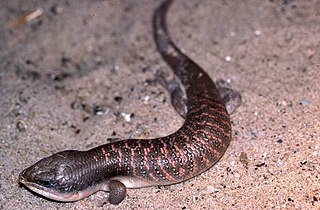
Acontias is a genus of limbless skinks, the lance skinks, in the African subfamily Acontinae. Most are small animals, but the largest member of the genus is Acontias plumbeus at approximately 40 cm (16 in) snout-vent length. All members of this genus are live-bearing sandswimmers, with fused eyelids. A recent review moved species that were formerly placed in the genera Typhlosaurus, Acontophiops, and Microacontias into this genus, as together these form a single branch in the tree of life. This new concept of Acontias is a sister lineage to Typhlosaurus, and these two genera are the only genera within the subfamily Acontinae.

Carlia is a genus of skinks, commonly known as four-fingered skinks or rainbow skinks, in the subfamily Eugongylinae. Before being placed in this new subfamily, Carlia was recovered in a clade with the genera Niveoscincus, Lampropholis, and others of the Eugongylus group within Lygosominae.
Glaphyromorphus is a genus of lizards in the skink family (Scincidae).

Lipinia is a genus of skinks, lizards in the family Scincidae. Species in the genus Lipinia are commonly called lipinias.
Melanoseps is a genus of lizards, known commonly as limbless skinks, in the family Scincidae. The genus is endemic to Sub-Saharan Africa.

Menetia is a genus of skinks, lizards in the family Scincidae. The member species of the genus Menetia are endemic to Australia. They are ground-dwellers and live in open forests and open grasslands.

Mochlus is a genus of skinks, lizards in the family Scincidae. The genus is endemic to Africa.

Ophiomorus is a genus of Old World skinks. The limbs are either reduced or absent, depending on the species. They are sometimes known as limbless skinks or snake skinks. Members of the genus live under rocks or in burrows.

Scelotes is a genus of small African skinks.
Sepsina is a genus of skinks. The genus is endemic to southern Africa.

The genus Sphenomorphus – vernacularly also known as the common skinks – currently serves as a "wastebin taxon" for numerous skinks. While most or all species presently placed here are probably rather close relatives, the genus as presently delimited is likely to be not monophyletic and is in need of review. Some species in this genus have been moved to Pinoyscincus.

George Albert Boulenger was a Belgian-British zoologist who described and gave scientific names to over 2,000 new animal species, chiefly fish, reptiles, and amphibians. Boulenger was also an active botanist during the last 30 years of his life, especially in the study of roses.

Eumeces algeriensis, commonly called the Algerian skink, Algerian orange-tailed skink, Berber's skink, in French eumece d'Algérie, or in Spanish bulán, is a species of skink in the family Scincidae. The species is endemic to the Maghreb region of North Africa.

Trachylepis is a skink genus in the subfamily Mabuyinae found mainly in Africa. Its members were formerly included in the "wastebin taxon" Mabuya, and for some time in Euprepis. As defined today, Trachylepis contains the clade of Afro-Malagasy mabuyas. The genus also contains a species from the Brazilian island of Fernando de Noronha, T. atlantica, and may occur in mainland South America with Trachylepis tschudii and Trachylepis maculata, both poorly known and enigmatic. The ancestors of T. atlantica are believed to have rafted across the Atlantic from Africa during the last 9 million years.

Anilios is a genus of snakes in the family Typhlopidae, first described in 1845 by John Edward Gray.

Morethia boulengeri is a species of lizard in the family Scincidae. The species is endemic to Australia.
Morethia butleri, also known commonly as Butler's Morethia and the woodland Morethia skink, is a species of lizard in the family Scincidae. The species is endemic to Australia.
The lined firetail skink is a species of skink found in Northern Territory, Western Australia and South Australia in Australia.
Morethia storri, also known commonly as the top end firetail skink or Storr's morethia, is a species of lizard in the family Scincidae. The species is endemic to Australia.
The northeastern firetail skink is a species of skink found in Queensland in Australia.













